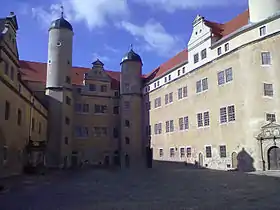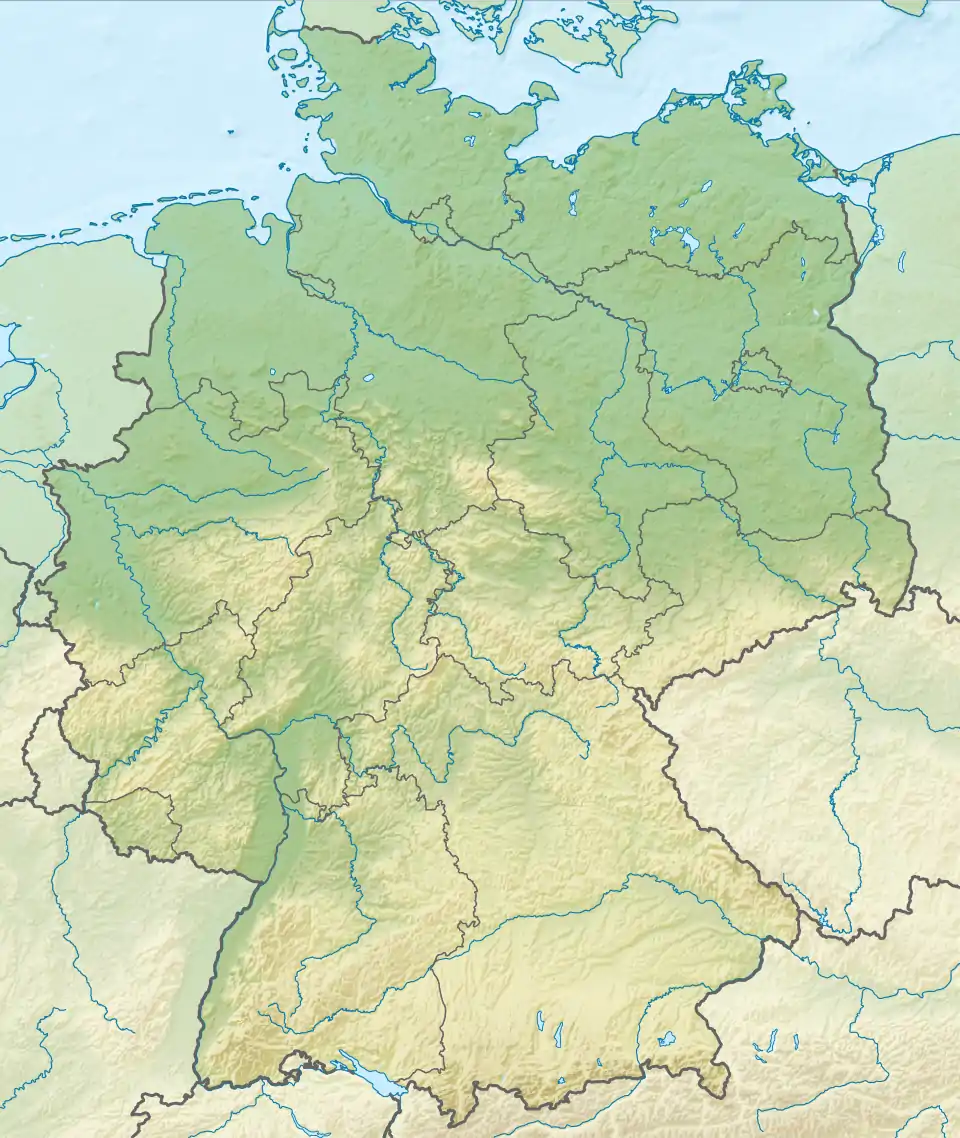Lichtenburg concentration camp
Lichtenburg was a Nazi concentration camp, housed in a Renaissance castle in Prettin, near Wittenberg in the Province of Saxony. Along with Sachsenburg, it was among the first to be built by the Nazis, and was operated by the SS from 1933 to 1939.[1] It held as many as 2000 male prisoners from 1933 to 1937 and from 1937 to 1939 held female prisoners.[2] It was closed in May 1939, when the Ravensbrück concentration camp for women was opened, which replaced Lichtenburg as the main camp for female prisoners.[3]
| Lichtenburg | |
|---|---|
| Concentration camp | |
 Lichtenburg Castle | |
 Location of Lichtenburg within Germany | |
| Coordinates | 51°39′45″N 12°55′55″E |
| Known for | One of the first Nazi concentration camps |
| Location | Prettin, Saxony |
| Operated by | Nazi Germany |
| Commandant |
|
| Operational | 13 June 1933–May 1939 |
| Inmates | Before 1937, male political prisoners; after 1937, female political prisoners |
| Number of inmates | More than 2,000 |
| Notable inmates | Lina Haag |
Operation
Details about the operation of Lichtenburg, held by the International Tracing Service, only became available to researchers in late 2006.[1] An account of the way the camp was run may be read in Lina Haag's book A Handful of Dust or How Long the Night. Haag was perhaps the best known survivor of Lichtenburg, having obtained release before it was shut down.
Lichtenburg was among the first concentration camps in Nazi Germany operating from 13 June 1933; it became a kind of model for numerous subsequent establishments. Soon overcrowded, the detention conditions became increasingly aggravated. Most of the inmates were political prisoners, and so-called habitual offenders (Gewohnheitsverbrecher). From 1937 on it became a camp only for women.[4] In 1939 the SS transferred 900 Lichtenburg prisoners to Ravensbrück, which were its first female prisoners.[5]
The castle today houses a regional museum and exhibit about Lichtenburg's use during the Nazi period.[2]
Personnel[6]
Camp commandant
- May 1934 – July 1934: SS-Brigadeführer Theodor Eicke
- July 1934 – March 1935: SS-Obersturmbannführer Bernhard Schmidt
- March 1935 – March 1936: SS-Standartenführer Otto Reich
- April 1936 – October 1936: SS-Standartenführer Hermann Baranowski
- November 1936 – July 1937: SS-Standartenführer Hans Helwig
- July 1937 – December 1937: Commisar Alexander Piorkowski
Protective custody chief
- July 1934 – February 1935: Edgar Entsberger
- February 1935 – April 1935 Karl Otto Koch
- April 1935 – October 1936 Heinrich Remmert
- November 1936 – August 1937 Egon Zill
Director of women's camp
- December 1937 – May 1939 Günther Tamaschke
Deputy director of camp
- December 1937 – August 1938 Alexander Piorkowski
- September 1938 – May 1939 Max Koegel
Notable inmates
- Olga Benario-Prestes, German-Brasilian resistance fighter
- Armin T. Wegner
- Walter Czollek
- Arthur Dietzsch
- Friedrich Ebert junior, Politician, son of Friedrich Ebert
- Philipp Fries
- Paul Frölich
- Ernst Grube
- Lina Haag,
- Lotti Huber, actress
- Erich Knauf
- Wolfgang Langhoff, actor
- Hans Litten, lawyer
- Wilhelm Leuschner, unionist
- Hans Lorbeer, author
- Karl Mache
- Charles Regnier, actor
- Ernst Reuter, Social Democrat
- Kurt von Ruffin, actor
- Gotthard Sachsenberg,
- Werner Scholem, Communist politician
- Fritz Thurm (1883–1937), Social Democrat
- Lisa Ullrich, Communist politician
- Ilse Unterdörfer missionary
References
- Holocaust Papers Pyramid of Persecution
- Lichtenburgprettin Germany
- "Ravensbrück Concentration Camp: Timeline of Persecution (1938 - 1945)". Jewish Virtual Library. Retrieved April 4, 2018.
- "Interview made possible with survivor of Lichtenburg concentration camp". ITS. International Tracing Service. Retrieved April 3, 2018.
- "Ravensbrück: Timeline". United States Holocaust Memorial Museum. Retrieved April 4, 2018.
- Stefan Hördler, Sigrid Jacobeit (Hrsg.): Dokumentations- und Gedenkort KZ Lichtenburg, Berlin 2009, p. 125ff.
Further reading
- Sarah Helm: Ravensbruck: Life and Death in Hitler's Concentration camp For Women. 2015 Penguin Random House, pps 4, 17-19, Prisoners sent from Lichtenberg to Ravensbruck 6-21.
- Stefan Hördler: Before the Holocaust: Concentration Camp Lichtenburg and the Evolution of the Nazi Camp System. Holocaust and Genocide Studies 25, no. 1 (Spring 2011): 100–126.
- Nikolaus Wachsmann: KL: A History of the Nazi Concentration Camps. 2015 Farrar, Straus and Giroux.